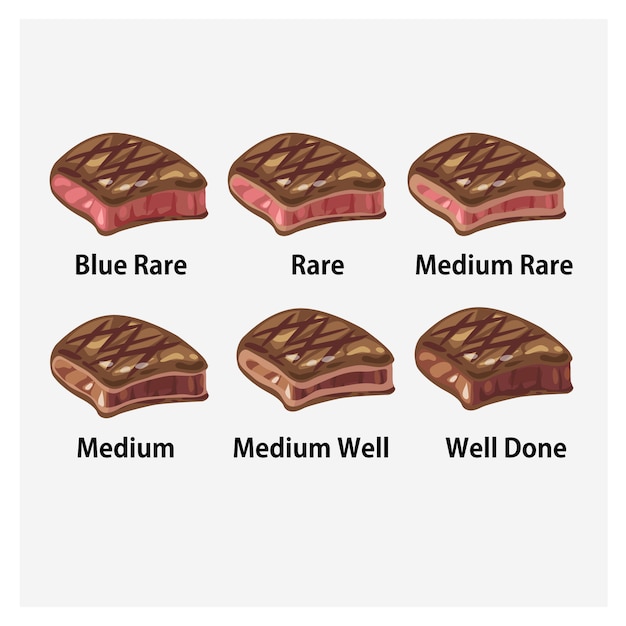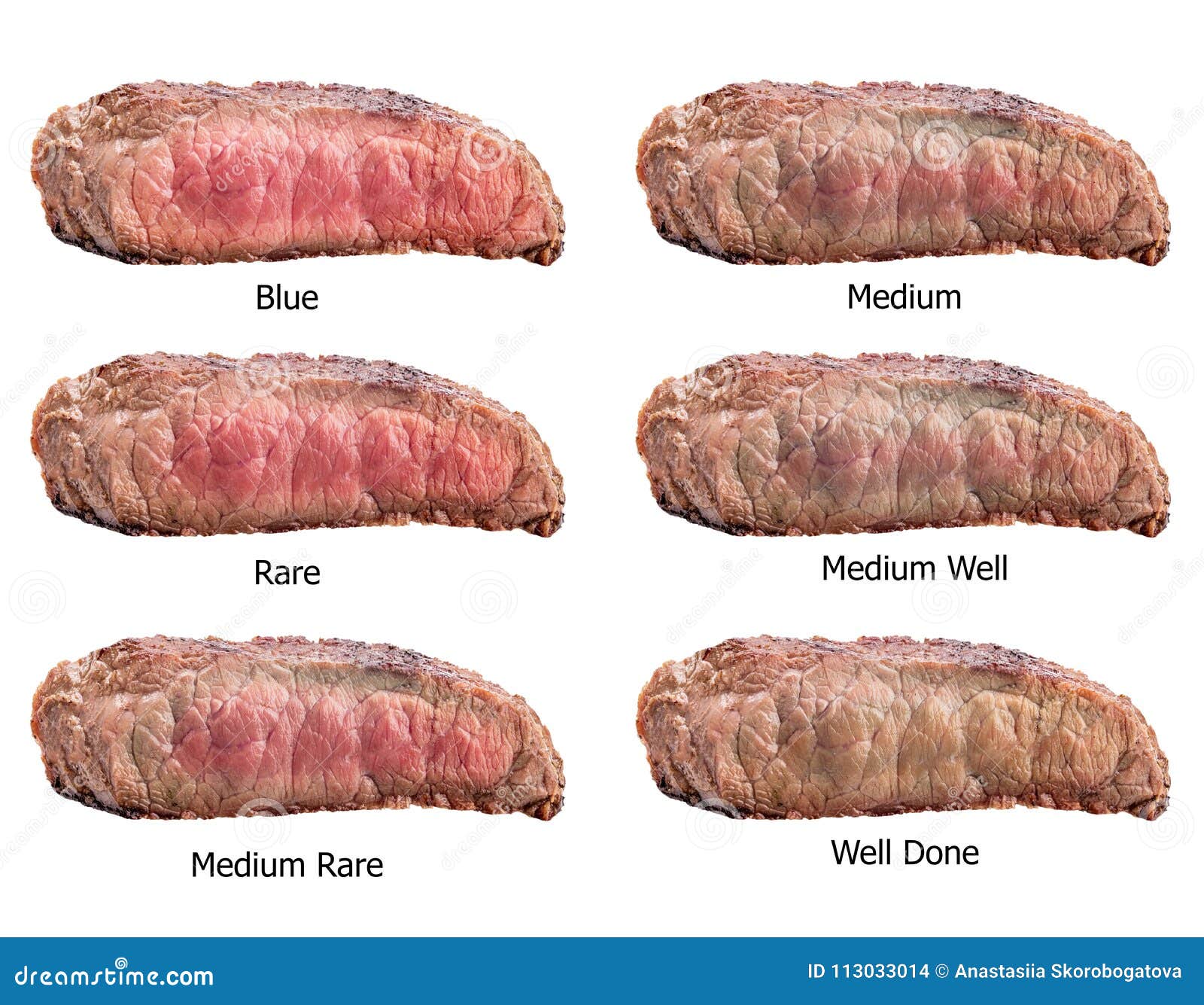Ever found yourself staring at a perfectly seared steak, unsure if its cooked just right? The key to culinary satisfaction often lies in understanding the nuanced differences between steak doneness levels, especially the often-debated distinction between medium well and medium rare.
Choosing the ideal level of doneness for your steak is far more than a matter of preference; it's a fundamental aspect of the dining experience. The degree to which a steak is cooked significantly influences its flavor profile, texture, and overall enjoyment. Whether youre a seasoned grill master or a home cook just starting out, a grasp of these variations will undeniably enhance your culinary journey. This article is designed to shed light on the critical differences between medium well and medium rare, helping you navigate the world of steak with newfound confidence and skill.
Let's embark on a detailed exploration of these two popular doneness levels, providing you with clear insights into their characteristics and cooking methods.
- Find Chickfila Anywhere The Truck Menu Where To Find It
- Temporary Replacement Episode 3 Dont Miss This
Here's a comprehensive guide to assist you in your quest for the perfect steak, exploring the intricacies of medium well and medium rare.
Table of Contents
- Understanding Steak Doneness Levels
- What is Medium Rare?
- What is Medium Well?
- Temperature Differences Between Medium Rare and Medium Well
- Texture and Flavor Comparison
- How to Cook Medium Rare and Medium Well Steaks
- Common Mistakes in Cooking Steak
- Health Considerations for Different Doneness Levels
- Frequently Asked Questions
Understanding Steak Doneness Levels
Steak doneness, at its core, refers to the degree to which a steak is cooked, a crucial aspect influencing its flavor, texture, and overall appeal. Each level of doneness presents a unique set of characteristics, dictated by internal temperature and cooking time. From the barely-kissed surface of a rare steak to the well-done consistency of a thoroughly cooked one, the variations are many. The ability to differentiate between these levels is critical for both the culinary enthusiast and the casual diner. Knowing these distinctions allows you to communicate your preferences effectively, ensuring a satisfactory dining experience.
Within the spectrum of steak doneness, medium rare and medium well stand out as popular choices, often surrounded by misconceptions. While both pertain to the steak's internal temperature, the nuances in texture and taste are quite significant. We will delve into these differences with clarity and precision.
- Blue Sexy Films Unveiling The World Of Sensual Storytelling
- Celine Dions Funeral Tributes Legacy Amp How Her Music Lives On
What is Medium Rare?
Medium rare represents a pinnacle of steak perfection for many, characterized by a warm, inviting red center, a succulent texture, and a burst of flavor. It is a popular choice amongst steak aficionados, a testament to its balance between tenderness and taste. A medium rare steak is cooked to achieve an internal temperature range of 130F to 135F (54C to 57C).
Characteristics of Medium Rare Steak
- Color: The center of the steak is a vivid pink, with a slight red hue.
- Texture: Juicy, tender, offering a yielding resistance when cut or bitten.
- Flavor: Rich, beefy flavor, complemented by a subtle char from the exterior crust.
What is Medium Well?
Medium well is a steak cooked to an internal temperature of 150F to 155F (65C to 68C). At this doneness level, the steak is primarily brown, with a slight blush of pink at its core. Favored by those who prefer their meat thoroughly cooked, medium well steaks offer a satisfying dining experience.
Characteristics of Medium Well Steak
- Color: The center is light pink to brown.
- Texture: Firmer and less juicy compared to medium rare, yet still possessing a degree of tenderness.
- Flavor: A less intense beefy flavor profile, with greater emphasis on the outer char and sear.
Temperature Differences Between Medium Rare and Medium Well
The fundamental distinction between medium rare and medium well lies in their internal temperatures. Medium rare steaks are cooked within a lower temperature range of 130F to 135F, allowing for a juicy and tender interior. Medium well steaks, on the other hand, reach a higher temperature range of 150F to 155F, resulting in a firmer texture and a more thoroughly cooked appearance.
The most reliable way to ensure your steak reaches the desired doneness is by using a meat thermometer. This instrument will confirm the internal temperature, preventing both undercooking and overcooking.
Texture and Flavor Comparison
The eating experience varies greatly, depending on the degree of doneness. Medium rare steaks are celebrated for their succulence and tenderness. Medium well steaks, while firmer and less juicy, are still enjoyable for those who favor more cooked meat.
Key Differences in Texture and Flavor
- Medium Rare: Juicy, tender, with a rich, pronounced beefy flavor.
- Medium Well: Firmer, less juicy, with a more subtle beefy flavor profile.
How to Cook Medium Rare and Medium Well Steaks
Creating the ideal steak requires paying close attention to the cooking process. Whether you're using a grill, skillet, or oven, monitoring the internal temperature and adjusting the cooking duration are paramount.
Steps to Cook Medium Rare Steak
- Preheat your grill or skillet to a high heat setting.
- Season your steak generously with salt, pepper, and your favorite herbs or spices.
- For a medium rare doneness, cook the steak for approximately 3-4 minutes per side.
- Use a meat thermometer to verify the internal temperature (130F to 135F).
- Allow the steak to rest for a few minutes before serving. This allows the juices to redistribute, resulting in a more tender and flavorful steak.
Steps to Cook Medium Well Steak
- Preheat your grill or skillet to a high heat setting.
- Season your steak with salt, pepper, and your preferred herbs and spices.
- Cook the steak for approximately 5-6 minutes per side for a medium well doneness.
- Use a meat thermometer to verify the internal temperature (150F to 155F).
- Allow the steak to rest for a few minutes before serving.
Common Mistakes in Cooking Steak
Even experienced cooks can make errors when cooking steak. It is essential to be aware of these, so you can avoid them:
- Not allowing the steak to rest before slicing.
- Overcooking the steak, resulting in dry and tough meat.
- Undercooking the steak, which poses potential food safety risks.
- Not employing a meat thermometer to accurately check the internal temperature.
Avoiding these mistakes will significantly increase your chances of achieving a perfect steak every time.
Health Considerations for Different Doneness Levels
When it comes to steak doneness, health considerations should also be kept in mind. Medium rare steaks tend to retain more moisture and a greater amount of nutrients compared to medium well steaks, which, as a result of extended cooking, can lose some nutritional value. Conversely, medium well steaks are the preferred choice for individuals who seek to reduce the potential risks associated with foodborne illnesses.
According to the USDA, it is recommended that steaks should be cooked to a minimum internal temperature of 145F (63C) to ensure that they are safe to eat. This temperature falls within the medium well range, making it a generally safe option for anyone who prioritizes food safety.
Frequently Asked Questions
Is Medium Well the Same as Medium Rare?
No, medium well and medium rare are not the same. Medium rare steaks are cooked to a lower temperature range of 130F to 135F, resulting in a pink and juicy center. Medium well steaks, on the other hand, are cooked to a higher temperature range of 150F to 155F, with a light pink to brown center.
Which Doneness Level is Healthier?
Both medium rare and medium well steaks have their own health benefits. Medium rare steaks retain more moisture and nutrients, while medium well steaks are safer in terms of foodborne illnesses. Ultimately, the choice depends on personal preference and dietary needs.
- Dive Into Temporary Replacement Ep 3 Hyungry Why It Matters
- Megan Fox From Small Town To Hollywood Icon The Untold Story

